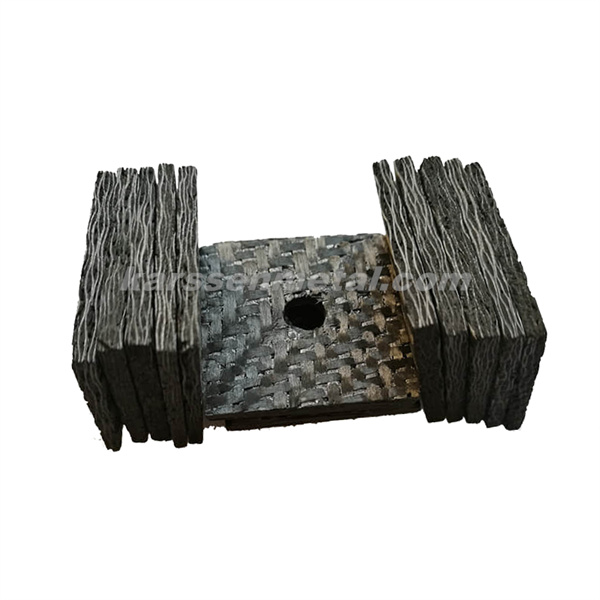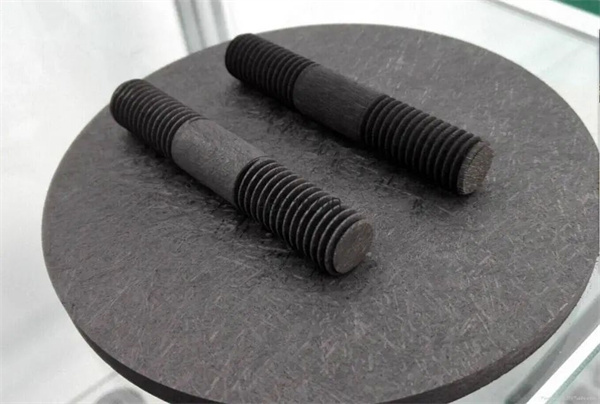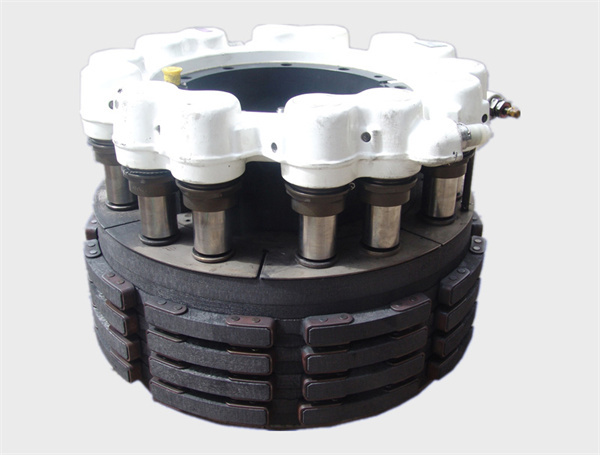Email: info@karssenmetal.com Tel: +86 18147353336
Carbon material refers to a non-metallic material obtained by using organic substances such as coal, petroleum or their processed products as the main raw material through a series of processing processes. The main components are carbon, diamond, graphite, graphene, carbon nanotubes, C /C composites all fall into this category.
In recent years, due to the development of aerospace andspecial metallurgy, higher requirements have been placed on the oxidation protection of carbon materials in high temperature environments. For example, C/C composite material is a new type of ultra-high temperature structural material that is currently being researched and developed in the field of new materials. It is a carbon-based composite material with carbon fiber or graphite fiber as reinforcement. Its full carbon structure not only retains the excellent mechanical properties and flexible structural designability of fiber as reinforced materials,it also has many advantages of carbon materials, such as low density, low thermal expansion coefficient, high thermal and high electricity conductivity, excellent thermal shock resistance, ablation resistance and friction resistance,etc.. Most importantly, the mechanical properties of the material do not decrease but increase with temperature, making it an ideal structural material in the fields of aerospace, automobiles, and medicine.

Although C/C composites have many excellent high-temperature properties, they also have a shortcoming that cannot be ignored, that is, oxidation reactions will occur in an aerobic environment with a temperature higher than 400 °C, resulting in a sharp decline in the performance of the material. Therefore, the application of C/C composites in a high-temperature aerobic environment must have oxidation protection measures.
1. Antioxidant method
At present, there are two main anti-oxidation methods for C/C composites: internal matrix modification technology to improve the antioxidant capacity of carbon fiber and matrix carbon by adding modification inhibitors, and external anti-oxidation coating technology to isolate oxygen-containing gas from contacting the matrix.
1.1 Matrix improvement technology: The matrix improvement technology can effectively achieve the low-temperature oxidation protection of C/C composites to a certain extent, but the added modification inhibitors (such as borates, phosphates) will affect the performance of the material, especially the high-temperature mechanical properties. The performance is adversely affected, and with the prolongation of anti-oxidation time and the increase of temperature, borate glass has higher vapor pressure and oxygen diffusion permeability after formation, so the effectiveness of its protection is limited below 1000 ℃.
1.2 Anti-oxidation coating technology: Compared with the matrix modification technology, the anti-oxidation coating technology can effectively isolate the diffusion contact between the carbon material and the external aerobic atmosphere, so as to achieve oxidation protection for a longer time and a wider temperature range. It is the most direct and effective method to improve the antioxidant performance of C/C composites, and it is also the most widely used and developed antioxidant protection technology.

2. Performance comparison of different coatings
2.1 Glass coating
Most of the coatings used in the early stage of research on the anti-oxidation technology of C/C composites are glass coatings. With the help of the low viscosity, good wettability and self-healing properties of glass at high temperature, it can fill in the defects such as cracks and holes caused by failure or deformation of the material during service, thereby isolating the surface active points of carbon materials and improving its antioxidant performance. At present, according to the different use environments, scholars have successively developed glass coatings such as phosphate, borate, silicate and modified borosilicate.
2.1.1 Phosphate glass coating
Phosphate glass coating is one of the earliest coating materials applied to C/C composites, and is often used to solve the problem of oxidation protection of C/C composites in the 500-1000 ℃ aircraft braking environment. It has good wettability to the C/C matrix material, and can effectively reduce the oxidation active points of the matrix material while filling defects such as holes on the surface of the matrix material, thereby reducing the oxidation rate; In addition, the phosphate coating acts as a carbon Brake disc anti-oxidation also has the advantages of low raw material price and simple brushing operation process, so it has been widely used in this field.

(A320 Carbon/carbon brake disc)
2.1.2 Boron, silicate glass coating
B2O3 glass has good wettability and thermal stability to carbon materials(reaction occurs at 1575 °C), and has good viscosity and fluidity at a temperature of 550 to 1000 °C, so it can effectively seal cracks, holes and other defects in carbon materials and form a dense oxide film on the surface of the material, thereby improving its oxidation resistance.
SiO2 glass has low oxygen permeability and vapor pressure at high temperature (<1800°C), and at 1200-1700°C, SiO2 glass has good flow and sealing properties, and can form a dense oxygen and carbon diffusion barrier on the surface of the coating after self-healing repair. So it has a significant oxidation protection effect on carbon materials at higher temperatures. But it also has obvious defects. When the temperature is lower than 1200 °C, it is difficult to provide crack and hole sealing performance due to high viscosity, poor wettability and fluidity, which can be improved by adding alkaline oxides.
2.1.3 Modified borosilicate composite glass coating
In recent years, with the development of composite coating technology, a new modified borosilicate composite glass coating system has been developed on the basis of the original B2O3 and SiO2 glass coatings. For example, the magnesium oxide + alumina modified borosilicate composite glass/SiC double-layer coating was oxidized in an air atmosphere of 1300 ° C for 150 hours, and the weight loss rate was only 1.07%.
2.2 Precious metal coating
Some metals such as Ir, Re, Hf, Cr, W, Mo, Zr, etc. also have very high melting points, especially the metal Ir, whose melting point is as high as 2410 °C, has extremely low oxygen and carbon permeability, and it does not react with carbon matrix at 2280℃. So this kind of material has also received great attention as a high-temperature anti-oxidation coating material for carbon materials.
2.3 ceramic coating
Many high-temperature ceramics are widely used as anti-oxidation coating materials due to their high melting point, good thermal stability and low coefficient of linear expansion. Therefore, ceramic coatings are the most deeply studied anti-oxidation coating systems, including silicon base ceramics, refractory oxide ceramics, refractory metal carbides and refractory metal boride ceramics.
2.3.1 Silicon-based ceramic coating
The successful development and application of silicon-based ceramic coatings mainly utilize the high-temperature self-healing function and low oxygen permeability of SiO2 glass. Due to the low oxygen diffusion coefficient of SiO2, it can effectively provide oxidation protection to the carbon matrix. Commonly used silicide coating materials are: SiO2, SiC, Si3N4, MoSi2, HfSi2, CrSi2, WSi2, TaSi2, NbSi2, ZrSi2, TiSi2, etc. Among them, SiC has received special attention as an anti-oxidation coating material for carbon materials. Such silicon-based ceramics not only have good chemical and physical compatibility with carbon materials, but also have a similar coefficient of linear expansion, so it is ideal antioxidant coating substance for high temperature carbon materials. .
2.3.2 Oxide ceramic coating
Oxides such as ZrO2 and HfO2 have a high melting point (>2700°C), and in a high-temperature oxidizing environment over 1800°C, they have better high temperature resistance, oxidation resistance and ablation resistance potential than silicide ceramics. The field of ultra-high temperature oxidation protection has received great attention in recent years. However, such oxide ceramics are easy to react with carbon at high temperature to form metal carbides. This problem can be solved by introducing an anti-oxidative transition inner layer between the oxide ceramics and the carbon matrix by using a composite coating process.
2.3.3 Refractory metal carbide ceramic coating
In recent years, with the development of hypersonic technology, the working temperature of C/C composite materials as a lightweight and high-temperature resistant key component material can reach up to 2000-2400 °C, and the duration is longer. In order to improve the erosion resistance, oxidation resistance and ablation resistance of C/C composite materials in ultra-high temperature gas environment, so as to withstand higher gas temperature or longer working time, it is necessary to prepare HfC, HfC, ZrC and other refractory metal carbide coatings to meet the requirements of use.
2.3.4 Refractory metal boride ceramic coating
Commonly used refractory metal boride coatings mainly include HfB2, ZrB2, TaB2, TiB2, etc. Similar to refractory metal carbides, refractory metal borides also have a very high melting point (>3000 ℃), so they can also be applied to ultra-high temperature oxidation protection of C/C composite materials above 2000 °C.
PS: Since the high-temperature oxidation resistance of the coating is greatly affected by the service environment of the material (most coating systems can only have good oxidation resistance under specific service conditions), therefore, how to improve the applicability of coatings in harsh environments, and how to combine traditional coatings with a variety of high-temperature anti-oxidation coatings to improve the comprehensive service performance of the coating system in all-temperature regions, have become the focus of current research.

(Multiphase Compound Antioxidant Coating System and Its Properties)
Isostatic graphite blocks are an important graph
Graphite rotor belongs to graphite material, whi
Graphite sheets have many important roles in the
Contact: Bateer
Phone: +86 18147353336
Tel: +86 18147353336
Email: info@karssenmetal.com
Add: Room D204-2203, Innovation Building, Baotou Light Industry Vocational Technical College, 19 Jianhua Road, Qingshan District, Baotou City, Inner Mongolia, China.